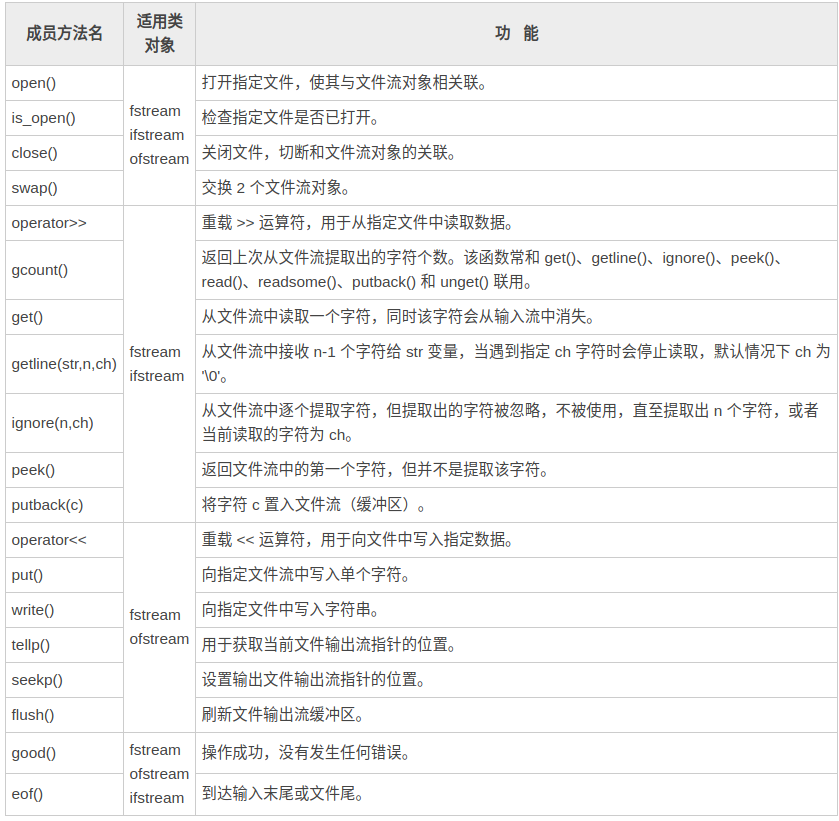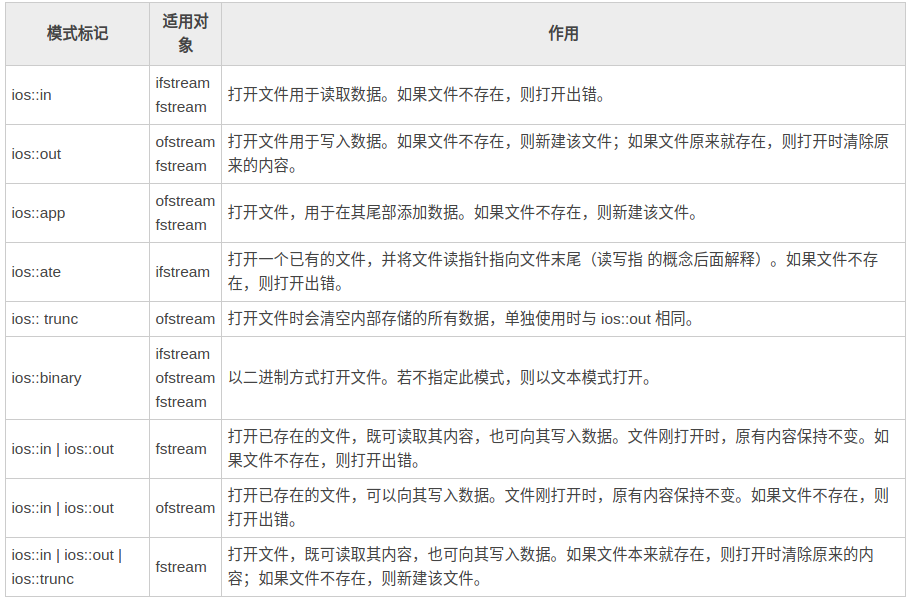C++入门 -- 文件流操作
计算机科学的角度来看,所有的文件都是由二进制位组成的,都是二进制文件。文本文件和其他二进制文件只是格式不同而已。
C++ 标准库中还专门提供了 3 个类用于实现文件操作,它们统称为文件流类,这 3 个类分别为:
- ifstream:专用于从文件中读取数据;
- ofstream:专用于向文件中写入数据;
- fstream:既可用于从文件中读取数据,又可用于向文件中写入数据。
以上三个类都在<fstream>头文件中,三个类的继承关系如下:

<iostream> 头文件中定义有 ostream 和 istream 类的对象 cin 和 cout 不同,<fstream> 头文件中并没有定义可直接使用的 fstream、ifstream 和 ofstream 类对象。
因此,如果我们想使用该类操作文件,需要自己创建相应类的对象。
为什么 C++ 标准库不提供现成的类似 fin 或者 fout 的对象呢?其实很简单,文件输入流和输出流的输入输出设备是硬盘中的文件,硬盘上有很多文件,到底应该使用哪一个呢?所以,C++ 标准库就把创建文件流对象的任务交给用户了。
fstream 类拥有 ifstream 和 ofstream 类中所有的成员方法,以下罗列了 fstream 类一些常用的成员方法。

示例:
1 #include <iostream> 2 #include <fstream> 3 4 using namespace std; 5 6 int main() { 7 const char *url = "tianyu"; 8 //创建一个fstream对象-文件流 9 fstream f1; 10 //将test.txt文件与f1文件流关联 11 f1.open("test.txt", ios::out); 12 //向test.txt文件中写入url字符串 13 f1.write(url, 10); 14 f1.close(); 15 return 0; 16 }
执行程序,该程序同目录下会生成一个 test.txt 文件,该文件的内容为:
tianyu
open打开文件
void open(const char* szFileName, int mode) //参数1:指向文件名的指针 //参数2:打开模式标记
文件打开模式标记“:

示例:流对象打开文件
#include <iostream> #include <fstream> using namespace std; int main() { //使用流对象的open成员函数打开文件 ifstream inFile("inFile.txt", ios::in); if(inFile) inFile.close(); else cout << "inFile.txt doesn't exist" << endl; //使用流对象的构造函数打开文件 ofstream oFile("inFile.txt", ios::out); if(!oFile) cout << "error 1" << endl; else oFile.close(); fstream oFile2("test1.txt", ios::in|ios::out|ios::trunc); oFile2.close(); return 0; }
close() 关闭文件流
在实际进行文件操作的过程中,对于打开的文件,要及时调用 close() 方法将其关闭,否则很可能会导致读写文件失败。
示例:
1 #include <iostream> //std::cout 2 #include <fstream> //std::ofstream 3 using namespace std; 4 5 int main() 6 { 7 const char * url = "http://c.biancheng.net/cplus/"; 8 //以文本模式打开out.txt 9 ofstream destFile("out.txt", ios::out); 10 if (!destFile) { 11 cout << "文件打开失败" << endl; 12 return 0; 13 } 14 //向out.txt文件中写入 url 字符串 15 destFile << url; 16 //程序抛出一个异常 17 throw "Exception"; 18 //关闭打开的 out.txt 文件 19 destFile.close(); 20 return 0; 21 }
17行抛出一个异常,若不处理即崩溃,导致没有close。
对于 destFile << url ,会先将字符串写到输出流缓冲区,待缓冲区满或者关闭文件时,数据才会写入到文件。直到崩溃,close都没执行
导致字符串一直在缓存区没有写入到文件
flush()刷新缓冲区
在很多实际场景中,即便已经对文件执行了写操作,但后续还可能会执行其他的写操作。对于这种情况,我们可能并不想频繁地打开/关闭文件,可以使用 flush() 方法及时刷新输出流缓冲区,也能起到防止写入文件失败的作用。
1 #include <iostream> //std::cout 2 #include <fstream> //std::ofstream 3 using namespace std; 4 5 int main() 6 { 7 const char * url = "http://c.biancheng.net/cplus/"; 8 //以文本模式打开out.txt 9 ofstream destFile("out.txt", ios::out); 10 if (!destFile) { 11 cout << "文件打开失败" << endl; 12 return 0; 13 } 14 //向out.txt文件中写入 url 字符串 15 destFile << url; 16 //刷新输出流缓冲区 17 destFile.flush(); 18 //程序抛出一个异常 19 throw "Exception"; 20 //关闭打开的 out.txt 文件 21 destFile.close(); 22 return 0; 23 }
在抛出异常崩溃前,刷新流缓冲区,会将字符串写入到文件。
C++ 中使用 open() 打开的文件,在读写操作执行完毕后,应及时调用 close() 方法关闭文件,或者对文件执行写操作后及时调用 flush() 方法刷新输出流缓冲区。
文件读写方法
1、使用 << 与 >> 实现读写文件:使用于文本形式读写文件;
2、使用read() 和 write() 成员方法读写文件:适用于二进制读写文件。
ostream::write()方法写文件
1 ostream & write(char* buffer, int count); 2 //buffer 用于指定要写入文件的二进制数据的起始位置; 3 //count 用于指定写入字节的个数
函数返回的是引用形式的对象,obj.write() 方法的返回值就是对 obj 对象的引用
注意:write方法会从文件写指针的位置将二进制数据写入,默然指向开头,若以 ios::app方式打开,则指向文件末尾
istream::read()方法读文件
1 istream & read(char* buffer, int count);、 2 //buffer 用于指定读取字节的起始位置 3 //count 指定读取字节的个数
移动和获取文件读写指针(seekp、seekg、tellg、tellp)
ostream & seekp (int offset, int mode); istream & seekg (int offset, int mode);
mode 代表文件读写指针的设置模式,有以下三种选项:
- ios::beg:让文件读指针(或写指针)指向从文件开始向后的 offset 字节处。offset 等于 0 即代表文件开头。在此情况下,offset 只能是非负数。
- ios::cur:在此情况下,offset 为负数则表示将读指针(或写指针)从当前位置朝文件开头方向移动 offset 字节,为正数则表示将读指针(或写指针)从当前位置朝文件尾部移动 offset字节,为 0 则不移动。
- ios::end:让文件读指针(或写指针)指向从文件结尾往前的 |offset|(offset 的绝对值)字节处。在此情况下,offset 只能是 0 或者负数
int tellg(); int tellp();
得到当前读写指针的具体位置:
- ifstream 类和 fstream 类还有 tellg 成员函数,能够返回文件读指针的位置;
- ofstream 类和 fstream 类还有 tellp 成员函数,能够返回文件写指针的位置。
要获取文件长度,可以用 seekg 函数将文件读指针定位到文件尾部,再用 tellg 函数获取文件读指针的位置,此位置即为文件长度。
示例:
1 std::vector<std::vector<char>> Avs::adjustLUT( 2 const std::string& calFileURL, const std::vector<std::string>& maskFileURLs, 3 const std::vector<AVS_ADJUST_S>& adjustParams) { 4 assert(maskFileURLs.size() == adjustParams.size()); 5 6 std::ifstream calFile(calFileURL, std::ios::binary); //binary:以二进制方式打开文件 7 assert(calFile.is_open()); 8 9 std::vector<char> calBuffer(AVS_CALIBRATION_FILE_LENGTH); 10 calFile.read(calBuffer.data(), calBuffer.size()); //从calFile读取size()大小的数据到calBuffer 11 12 //将数个maskFile存入到maskBuffer容器中 13 std::vector<std::vector<char>> maskBuffers; 14 for (auto& url : maskFileURLs) { 15 std::ifstream file(url, std::ios::binary); //将maskFile与file对象绑定 16 assert(file.is_open()); 17 file.seekg(0, file.end); //将文件指针指向文件尾 18 19 //创建一个大小为文件长度大小的容器buffer 20 std::vector<char> buffer(file.tellg()); //tellg 函数获取文件读指针的位置,此位置即为文件长度 21 file.seekg(0, file.beg); //文件指针指向文件开始处 22 file.read(buffer.data(), buffer.size()); //从file(maskFile)读取size大小的数据到buffer 23 maskBuffers.push_back(std::move(buffer)); //每循环一次,在maskBuffer容器后加入一个Buffer 24 } 25 26 ... 27 }
注意:
- C++ 标准库使用比如vector::push_back 等这类函数时,会对参数的对象进行复制,连数据也会复制.这就会造成对象内存的额外创建, 本来原意是想把参数push_back进去就行了,通过std::move,可以避免不必要的拷贝操作。
- std::move是将对象的状态或者所有权从一个对象转移到另一个对象,只是转移,没有内存的搬迁或者内存拷贝所以可以提高利用效率,改善性能.。
- 对指针类型的标准库对象并不需要这么做.
原lvalue值被moved from之后值被转移,所以为空字符串.。一般在代码段的末尾使用move(value),被转移所有权的value不可以再次被使用
move用法示例:
//摘自https://zh.cppreference.com/w/cpp/utility/move #include <iostream> #include <utility> #include <vector> #include <string> int main() { std::string str = "Hello"; std::vector<std::string> v; //调用常规的拷贝构造函数,新建字符数组,拷贝数据 v.push_back(str); std::cout << "After copy, str is \"" << str << "\"\n"; //调用移动构造函数,掏空str,掏空后,最好不要使用str v.push_back(std::move(str)); std::cout << "After move, str is \"" << str << "\"\n"; std::cout << "The contents of the vector are \"" << v[0] << "\", \"" << v[1] << "\"\n"; }
输出:
After copy, str is "Hello" After move, str is "" The contents of the vector are "Hello", "Hello"



